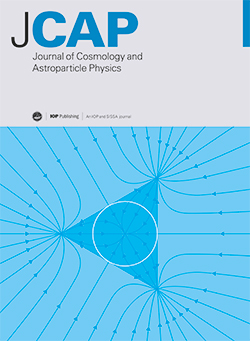基于HERA预测的热暗物质模拟推断
IF 5.9
2区 物理与天体物理
Q1 ASTRONOMY & ASTROPHYSICS
Journal of Cosmology and Astroparticle Physics
Pub Date : 2025-06-30
DOI:10.1088/1475-7516/2025/07/004
引用次数: 0
摘要
来自宇宙黎明号的21厘米红移信号有望打开一扇新的窗口,了解我们宇宙的早期历史,并使探测前所未有的移动调查量成为可能。在这项工作中,我们重新审视了温暖暗物质(WDM)在21cm信号功率谱上的印记,使用了公共代码21cmFast中WDM效应的更新实现,并考虑了单一的宇宙黎明星系群。通过推断WDM质量,我们分析了后者与表征恒星形成和x射线加热的天体物理参数之间的简并,并强调了恒星形成星系的阈值质量Mturn的作用。采用基于模拟推理的统计方法,研究了新建成的HERA望远镜重建WDM质量的能力。我们对算法训练中使用的不同数量的模拟进行了每参数重建质量的比较。我们的结果表明,如果宇宙黎明星系的阈值质量Mturn > 108M⊙,那么HERA可能会超越目前的莱曼α森林约束。本研究中考虑的x射线源性质也可能影响低阈值质量时WDM约束的强度。本文章由计算机程序翻译,如有差异,请以英文原文为准。
Simulation-based inference on warm dark matter from HERA forecasts
The redshifted 21cm signal from Cosmic Dawn promises to open a new window into the early history of our universe and enable the probing of an unprecedented comoving survey volume. In this work, we revisit the imprint of Warm Dark Matter (WDM) on the 21cm signal power spectrum using an updated implementation of the WDM effect in the public code 21cmFast and considering a single population of cosmic dawn galaxies. By focusing on inferring the WDM mass, we analyze the degeneracies between the latter and the astrophysics parameters characterizing star formation and X-ray heating and we emphasize the role of the threshold mass for star-forming galaxies, Mturn. We study the capability of the recently built HERA telescope to reconstruct the WDM mass by adopting the statistical approach of simulation-based inference. We include a comparison of the per-parameter reconstruction quality for different number of simulations used in the training of the algorithm. Our results indicate that HERA could surpass current Lyman-α forest constraints if Cosmic Dawn galaxies exhibit a threshold mass Mturn ≲ 108M⊙. The X-ray source properties considered in this study may also influence the strength of the WDM constraint for lower threshold masses.
求助全文
通过发布文献求助,成功后即可免费获取论文全文。
去求助
来源期刊

Journal of Cosmology and Astroparticle Physics
地学天文-天文与天体物理
CiteScore
10.20
自引率
23.40%
发文量
632
审稿时长
1 months
期刊介绍:
Journal of Cosmology and Astroparticle Physics (JCAP) encompasses theoretical, observational and experimental areas as well as computation and simulation. The journal covers the latest developments in the theory of all fundamental interactions and their cosmological implications (e.g. M-theory and cosmology, brane cosmology). JCAP''s coverage also includes topics such as formation, dynamics and clustering of galaxies, pre-galactic star formation, x-ray astronomy, radio astronomy, gravitational lensing, active galactic nuclei, intergalactic and interstellar matter.
 求助内容:
求助内容: 应助结果提醒方式:
应助结果提醒方式:


